标签:val histogram height tick sub == numpy pass style
1. Subplots
%matplotlib notebook import matplotlib.pyplot as plt import numpy as np plt.figure() # subplot with 1 row, 2 columns, and current axis is 1st subplot axes plt.subplot(1, 2, 1) linear_data = np.array([1,2,3,4,5,6,7,8]) # plot exponential data on 1st subplot axes plt.plot(linear_data, ‘-o‘) exponential_data = linear_data **2 # subplot with 1 row, 2 columns, and current axis is 2nd subplot axes plt.subplot(1, 2, 2) plt.plot(exponential_data) plt.subplot(1, 2, 1) plt.plot(exponential_data) # Create a new figure plt.figure() ax1 = plt.subplot(1, 2, 1) plt.plot(linear_data, ‘-o‘) # pass sharey=ax1 to ensure the two subplots share the same y axis ax2 = plt.subplot(1, 2, 2, sharey=ax1) plt.plot(exponential_data, ‘-x‘)
Output:
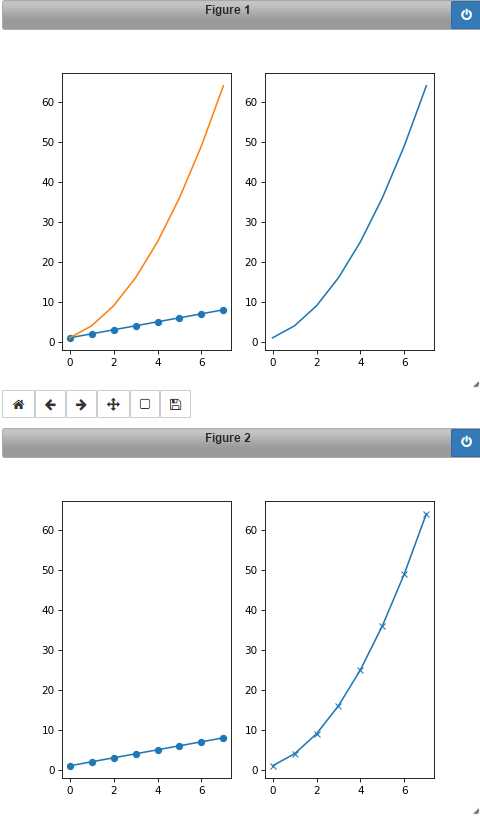
# create a 3x3 grid of subplots fig, ((ax1,ax2,ax3), (ax4,ax5,ax6), (ax7,ax8,ax9)) = plt.subplots(3, 3, sharex=True, sharey=True) # plot the linear_data on the 5th subplot axes ax5.plot(linear_data, ‘-‘) # set inside tick labels to visible for ax in plt.gcf().get_axes(): for label in ax.get_xticklabels() + ax.get_yticklabels(): label.set_visible(True) # necessary on some systems to update the plot plt.gcf().canvas.draw()
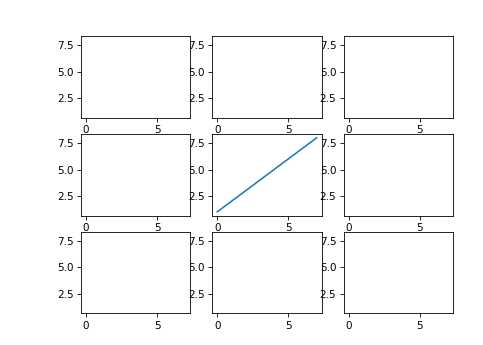
2 .Histogram
import numpy as np import matplotlib.pyplot as plt # create 2x2 grid of axis subplots fig, ((ax1, ax2), (ax3, ax4)) = plt.subplots(2, 2, sharex=True) axs = [ax1,ax2,ax3,ax4] # draw n = 10, 100, 1000, and 10000 samples from the normal distribution and plot corresponding histograms for i, ax in enumerate(axes): sample = np.random.normal(0, 1, 10**(i+1)) ax.hist(sample, bins=100) ax.set_title(‘n={}‘.format(10**(i+1)))
Output:
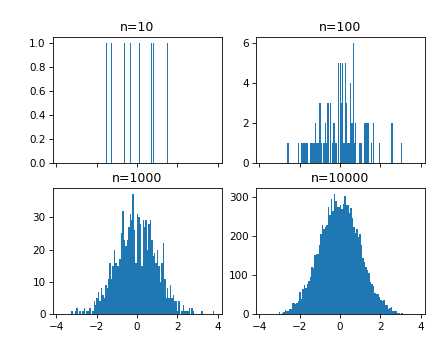
import matplotlib.gridspec as gridspec plt.figure() gspec = gridspec.GridSpec(3,3) top_histogram = plt.subplot(gspec[0, 1:]) side_histogram = plt.subplot(gspec[1:, 0]) lower_right = plt.subplot(gspec[1:, 1:]) Y = np.random.normal(loc=0.0, scale=1.0, size=10000) X = np.random.random(size=10000) lower_right.scatter(X, Y) top_histogram.hist(X, bins=100) s = side_histogram.hist(Y, bins=100, orientation=‘horizontal‘) # # clear the histograms and plot normed histograms top_histogram.clear() top_histogram.hist(X, bins=100, normed=True) side_histogram.clear() side_histogram.hist(Y, bins=100, orientation=‘horizontal‘, normed=True) # flip the side histogram‘s x axis side_histogram.invert_xaxis() # change axes limits for ax in [top_histogram, lower_right]: ax.set_xlim(0, 1) for ax in [side_histogram, lower_right]: ax.set_ylim(-5, 5)
Output:
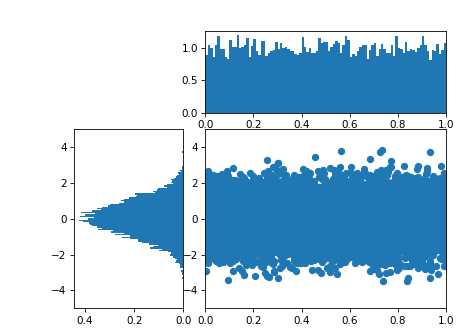
3. Box plots
import matplotlib.pyplot as plt import mpl_toolkits.axes_grid1.inset_locator as mpl_il import pandas as pd normal_sample = np.random.normal(loc=0.0, scale=1.0, size=10000) random_sample = np.random.random(size=10000) gamma_sample = np.random.gamma(2, size=10000) df = pd.DataFrame({"normal":normal_sample, "random": random_sample, "gamma":gamma_sample}) plt.figure() # if `whis` argument isn‘t passed, boxplot defaults to showing 1.5*interquartile (IQR) whiskers with outliers _ = plt.boxplot([ df[‘normal‘], df[‘random‘], df[‘gamma‘] ], whis=‘range‘) # overlay axis on top of another ax2 = mpl_il.inset_axes(plt.gca(), width=‘60%‘, height=‘40%‘, loc=2) ax2.hist(df[‘gamma‘], bins=100) # switch the y axis ticks for ax2 to the right side ax2.yaxis.tick_right()
Output:
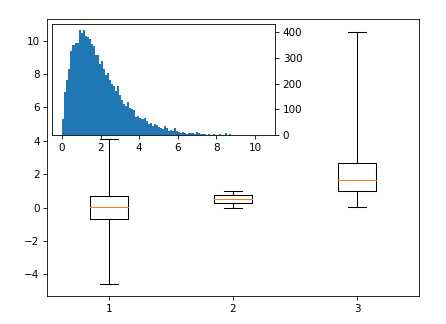
4. Heartmap
import matplotlib.pyplot as plt import numpy as np plt.figure() Y = np.random.normal(loc=0.0, scale=1.0, size=10000) X = np.random.random(size=10000) plt.figure() _ = plt.hist2d(X, Y, bins=100) # add a colorbar legend plt.colorbar()
Output:
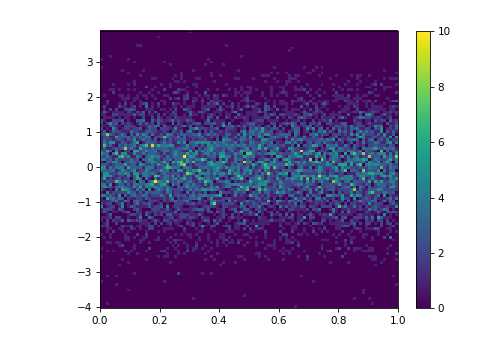
5. Animation
import matplotlib.animation as animation import matplotlib.pyplot as plt import numpy as np plt.figure() n = 100 x = np.random.randn(n) plt.hist(x, bins=10) # create the function that will do the plotting, where curr is the current frame def update(curr): # check if animation is at the last frame, and if so, stop the animation a if curr == n: a.event_source.stop() # Clear the current axis plt.cla() bins = np.arange(-4, 4, 0.5) plt.hist(x[:curr], bins=bins) plt.axis([-4,4,0,30]) plt.gca().set_title(‘Sampling the Normal Distribution‘) plt.gca().set_ylabel(‘Frequency‘) plt.gca().set_xlabel(‘Value‘) plt.annotate(‘n = {}‘.format(curr), [3,27]) fig = plt.figure() a = animation.FuncAnimation(fig, update, interval=100)
Output:
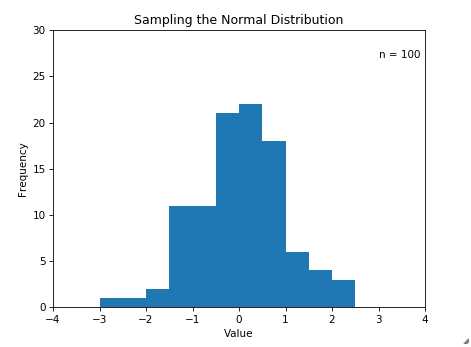
6. Interactivity
Mousing clickigng
import matplotlib.pyplot as plt import numpy as np plt.figure() data = np.random.rand(10) plt.plot(data) def onclick(event): plt.cla() plt.plot(data) plt.gca().set_title(‘Event at pixels {},{} \nand data {},{}‘.format(event.x, event.y, event.xdata, event.ydata)) # tell mpl_connect we want to pass a ‘button_press_event‘ into onclick when the event is detected plt.gcf().canvas.mpl_connect(‘button_press_event‘, onclick)
Output:
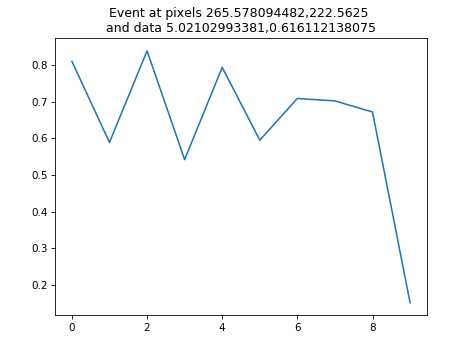
from random import shuffle origins = [‘China‘, ‘Brazil‘, ‘India‘, ‘USA‘, ‘Canada‘, ‘UK‘, ‘Germany‘, ‘Iraq‘, ‘Chile‘, ‘Mexico‘] shuffle(origins) df = pd.DataFrame({‘height‘: np.random.rand(10), ‘weight‘: np.random.rand(10), ‘origin‘: origins}) plt.figure() # picker=5 means the mouse doesn‘t have to click directly on an event, but can be up to 5 pixels away plt.scatter(df[‘height‘], df[‘weight‘], picker=10) plt.gca().set_ylabel(‘Weight‘) plt.gca().set_xlabel(‘Height‘) def onpick(event): origin = df.iloc[event.ind[0]][‘origin‘] plt.gca().set_title(‘Selected item came from {}‘.format(origin)) # tell mpl_connect we want to pass a ‘pick_event‘ into onpick when the event is detected plt.gcf().canvas.mpl_connect(‘pick_event‘, onpick)
Output:
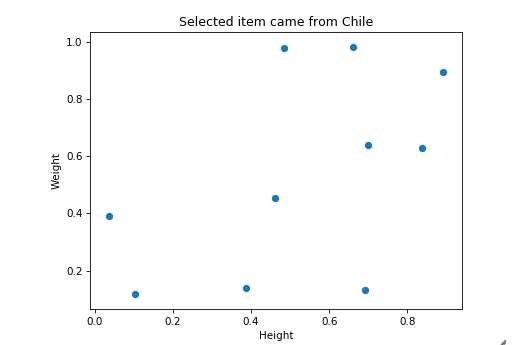
Data manipulation in python (module 5)
标签:val histogram height tick sub == numpy pass style
原文地址:http://www.cnblogs.com/climberclimb/p/6985255.html